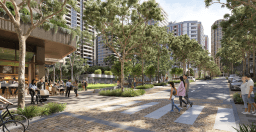Macquarie Park: The northern Sydney suburb that’s a hotspot for innovation
Just 22 years after becoming a suburb in its own right, Macquarie Park has powered ahead as a hotspot for innovation, business, education and health.
Once home to market gardens and poultry farms, Macquarie Park in Sydney’s north west has evolved to become NSW’s largest business centre outside Sydney’s CBD, with a growing number of international and Australian companies and institutions calling it home including CSIRO, AMP Capital, NAB, Johnson & Johnson, Cochlear and Fujitsu.
Macquarie University, which ranked in the top one per cent of universities worldwide last year, occupies 126 hectares in the suburb’s north and is home to Australia’s first and only private, not-for-profit teaching hospital on a university campus.
Strategic urban planning ensures the northern Sydney suburb also has top connectivity. Macquarie Park has two new Metro train stations, easy access to the nearby M2 motorway and frequent bus services to the CBD.
But it’s not all business, with diverse leisure choices providing work-life balance.
The Macquarie Centre has 360 speciality shops, cinemas, supermarkets, and an ice-skating rink, with dining options ranging from the multi-award-winning restaurant Chef’s Gallery to a vast range of delicious choices in its food courts. Local favourites beyond the centre include Verace Pizzeria and Kin By Us.
Those looking to get active can make use of local basketball, tennis, football and fitness facilities as well as the university’s sports and aquatic centre. They can also walk, hike and cycle through bushland and along the river in the adjoining 372-hectare Lane Cove National Park.
These advantages attracted leading developer Frasers Property Australia, who in partnership with the NSW Government, has masterplanned a $2.1 billion community on 8.2 hectares in the suburb’s centre.
Planned as Sydney’s “next great urban neighbourhood”, Midtown MacPark is designed to provide intelligent, sustainable living integrated with community facilities for approximately 6500 residents, and to add further amenity to its locale.
“We are absolute believers in Macquarie Park,” says Frasers Property general manager development Nigel Edgar. “We chose to participate in Midtown because we believe in the value of the Macquarie Park area.”
Midtown is the third and largest development in the area for Frasers Property; the developer completed Centrale at North Ryde in 2018 and is developing a commercial building at the Macquarie Park train station.
Edgar says Midtown’s enviable location provides everything required by a thriving community. There’s easy access to work, transport options, childcare, schools, university, medical facilities, shopping and parks.
“To be able to walk just 500 metres to a train station, NSW’s largest business and shopping districts outside the CBD, and to a world-class university and hospital is extraordinary,” he says.
Midtown will deliver the greater Macquarie Park community a bonus in communal amenities including a state-of-the-art community centre, pool, gym, two childcare centres, cafes and convenience stores. A co-ed primary school is also planned for the precinct.

In addition, a third of Midtown’s site will be devoted to green space. Outdoor features include a 6000-square metre park, 5000 square metres in riparian trails, and pocket parks with playgrounds and exercise stations.
Eighteen buildings designed by leading architects including Bates Smart, Hassell, Candalepas Associates and Cox Architecture will provide the neighbourhood’s 3300 mixed-tenure residences. Designed for diversity, the apartments and townhouses will create options for young families, singles and couples, downsizers, investors, students, community housing tenants and local workers.
Midtown’s first building, the 24-storey MAC Residences, will offer residents sweeping district and city views from many of its 269 apartments and is designed to serve as a gateway to the community.
View original article - Link
Author: Liz McLachlan. Header image: Artist's impression. Indicative only








